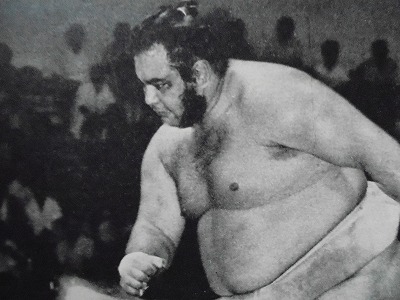This Chapter elucidates shikona of Non-Japanese rikishi instead of introducing kanji as part of shikona. Over 40 years have past since the late 1960s when “高見山” (Taka-Mi-Yama), a rikishi from Hawaii started to become popular as a strong rikishi. He was the pioneer as a Non-Japanese rikishi.
The past 40 years saw a certain change in the tendency of shikona of Non-Japanese rikishi, and this change must have something to do with a change in the way of thinking of their trainers (Oyakata) who named Non-Japanese rikishi.
As I introduced in Chapter 4, many types of kanji for wild animals are used as part of shikona of Mongolian rikishi. This is one of the interesting characteristics of their shikona. Now I am going to introduce intriguing characteristics of shikona of Hawaiian and European rikishi respectively. Learning these characteristics, you may feel any change in Japanese awareness or attitude toward Non-Japanese rikishi.
・Shikona of Hawaiian Rikishi
“高見山” (Taka-Mi-Yama)
Takamiyama was the first Non-Japanese sumo wrestler. This Non-Japanese rikishi flourished and successfully kept himself within the top-division (“幕内” (maku-uchi )) of Professional Sumo Competitions for as long as 16 years from the late 1960s to the early 1980s. His above achievement has been recorded as the longest-term existence within the top-division in the history of Professional Sumo. This shikona was named him after the 1st generation of Takamiyama who had been a skilled rikishi flourishing around 1910. So, this first Non-Japanese rikishi was the 2nd generation.
“小錦” (Ko-Nishiki )
Konishiki was a very strong rikishi and ranked as Ozeki flourishing around 1990. He was so strong that he was almost close to Yokozuna in those days. This shikona was named him after the 1st generation of Konishiki who had been a splendid rikishi flourishing around 1890. This Hawaiian rikishi was the 3rd generation.
“曙” (Akebono)
Akebono became the first Non-Japanese Yokozuna back in 1993. His shikona, Akebono is an original one, standing for dawn. This kanji (word) often appears in Japanese classical literatures to describe the beauty of early morning. So, when he was named this shikona, his trainer must have wanted to use something very Japanese and traditional for his.
As explained above, Hawaiian rikishi, the pioneers of Non-Japanese rikishi were named more Japanese shikona than normal Japanese rikishi. Usually shikona of historically remarkable rikishi are not handed down to ordinary rikishi. However, such shikona were handed down to those Hawaiian rikishi. Therefore, their sumo trainers (Oyakata) must have wanted them to getting used to Japanese style of wrestling and be treated equally as Japanese rikishi as early as possible by naming them previously famous shikona on purpose.
・Shikona of European Rikishi
“琴欧洲” (Koto-Ou-Shu)
Kotooushu is a Bulgarian rikishi. “欧洲” stands for “Europe” in Japanese. So, his shikona is made up of the kanji for Europe together with “琴” a kanji from his trainer’s previous shikona.
“露鵬” (Ro-Hou)
Rohou is a Russian rikishi. “露” stands for “Russia” in Japanese. So, his shikona is made up of the kanji for Russia together with “鵬” a kanji from his trainer’s previous shikona.
“黒海” (Kok-Kai )
Kokkai is a Georgian rikishi. “黒海” stands for the inland sea facing his home country, Georgia. His trainer symbolically gave him the name of the sea as his shikona.
“把瑠都” (Ba-Ru-To)
Baruto is an Estonian rikishi. “Baruto” is the Japanese reading of the Baltic Sea facing his home country, Estonia. His trainer symbolically gave him the name of the sea as his shikona.
Different from the foregoing Hawaiian rikishi whose shikona was very Japanese, European rikishi were named symbolic shikona after their home countries, and we can tell by their shikona where they are originally from. This is supposedly because of a certain change in their sumo trainer’s awareness or attitude toward Non-Japanese rikishi.


